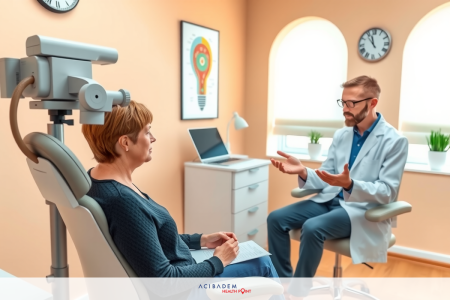Understanding Adult Exotropia
Adult Exotropia: Symptoms, Causes, and Treatment Adult exotropia is a condition characterized by the outward misalignment of one or both eyes in adults. This eye divergence can result in various visual disturbances, such as double vision, reduced depth perception, and difficulty focusing on objects.
Adult exotropia occurs when the muscles that control eye movement are imbalanced, causing one eye to deviate outwardly. This misalignment can be constant or intermittent, and it may become more apparent when focusing on distant objects or during times of fatigue or stress.
It is crucial to understand the nature of adult exotropia in order to address its symptoms effectively. By recognizing the signs of eye misalignment in adults, individuals can seek appropriate treatment and prevent potential complications. Early intervention can also help improve visual comfort and overall quality of life.
Symptoms of Adult Exotropia
Adult exotropia, a condition characterized by the outward deviation of one or both eyes, can manifest with various symptoms. Early recognition of these symptoms is crucial for prompt intervention and treatment. Common adult exotropia symptoms include:
- Noticeable outward deviation of one or both eyes: Misalignment of the eyes is a hallmark symptom of adult exotropia. The affected eye or eyes may deviate outward, away from the midline.
- Crossing of the eyes when focusing on near objects: Individuals with adult exotropia may experience inward or upward crossing of the eyes when looking at objects up close.
- Eyestrain or fatigue: The effort required to focus and align the eyes properly can lead to eyestrain and fatigue, especially during activities that demand visual concentration.
Recognizing these symptoms can facilitate early intervention and prevent potential complications associated with adult exotropia. If you or a loved one experiences any of these symptoms, it is advisable to seek an evaluation by an eye care specialist.
| Symptom | Description |
|---|---|
| Noticeable outward deviation of one or both eyes | The eyes visibly deviate outward, away from the midline, leading to misalignment. |
| Crossing of the eyes when focusing on near objects | The eyes may inwardly or upwardly cross when attempting to focus on objects in close proximity. |
| Eyestrain or fatigue | The effort required by the eyes to maintain alignment can lead to tiredness and eye discomfort. |
Causes of Adult Exotropia
Adult exotropia can occur due to various factors, including:
- A history of childhood strabismus: Adults who had strabismus (misaligned eyes) during their childhood that wasn’t properly treated may develop adult exotropia later in life.
- Nerve or muscle abnormalities: Abnormalities in the nerves or muscles responsible for controlling eye movement can contribute to adult exotropia.
- Neurological conditions: Certain neurological conditions, such as a stroke or traumatic brain injury, can cause adult exotropia.
Identifying the underlying causes of adult exotropia is essential in determining the most appropriate treatment plan. A thorough evaluation by an eye care specialist can help identify these causes and guide the treatment approach.
| Cause | Description |
|---|---|
| History of childhood strabismus | Adults who experienced misaligned eyes during childhood and didn’t receive adequate treatment may develop adult exotropia. |
| Nerve or muscle abnormalities | Abnormalities in the nerves or muscles responsible for controlling eye movement can lead to adult exotropia. |
| Neurological conditions | Certain neurological conditions, such as stroke or traumatic brain injury, can result in adult exotropia. |
Diagnosing Adult Exotropia
Diagnosing adult exotropia requires a comprehensive eye examination that includes a thorough evaluation of eye alignment, visual acuity, and ocular motility. The process involves various tests to assess the extent of the condition and identify any underlying factors.
Evaluating Eye Alignment and Visual Acuity
The eye care specialist will carefully examine the alignment of the eyes, looking for any noticeable outward deviation. Visual acuity tests will be conducted to assess how clearly the patient can see at various distances. These assessments provide valuable insights into the severity of adult exotropia and help guide treatment decisions.
Assessing Ocular Motility
Ocular motility involves evaluating the movements and coordination of the eyes. The eye care specialist will assess how well the patient can track moving objects, follow a specific target, and focus on different distances. These tests help determine the extent to which adult exotropia affects the individual’s eye movement capabilities.
Additional Tests for Underlying Conditions
In some cases, additional tests may be necessary to identify underlying conditions that may be contributing to adult exotropia. These tests could include imaging studies, such as MRI or CT scans, to evaluate the structures of the eyes and surrounding areas. Neurologic assessments may also be conducted to rule out any neurological disorders.
By conducting a comprehensive eye examination and additional tests as needed, eye care specialists can accurately diagnose adult exotropia and develop an appropriate treatment plan tailored to each individual’s unique needs.
Treatment Options for Adult Exotropia
Treatment for adult exotropia aims to address the misalignment of the eyes and improve visual function. The approach to treatment may vary depending on the severity of the condition and the presence of underlying factors. It is crucial to consult with an eye care specialist who can assess the individual’s specific needs and recommend the most appropriate treatment options.
Vision Therapy
Vision therapy is a non-surgical treatment option that involves specialized exercises and activities designed to improve eye coordination and strengthen the eye muscles. It can be beneficial for certain cases of adult exotropia, particularly when the condition is mild and not associated with significant underlying factors. Vision therapy aims to retrain the eyes and enhance binocular vision, improving eye alignment and reducing symptoms of exotropia.
Prism Glasses
Another treatment option for adult exotropia is the use of prism glasses. These special glasses contain prism lenses that can help shift the image seen by the deviated eye, thereby reducing the outward eye deviation. Prism glasses are particularly useful for individuals with milder forms of exotropia or those who may not be suitable candidates for surgery. Adult Exotropia Symptoms Causes
Surgical Intervention
In more severe cases of adult exotropia or when non-surgical approaches have not provided satisfactory results, surgery may be recommended. The goal of surgery is to realign the eyes by adjusting the eye muscles responsible for eye movement. The procedure is typically performed by an ophthalmologist with expertise in eye muscle surgery. Surgical intervention for adult exotropia can help improve eye alignment, enhance binocular vision, and alleviate symptoms.
It is important to note that the choice of treatment for adult exotropia should be made in consultation with an eye care specialist. They will consider factors such as the severity of the condition, the presence of underlying factors, and the individual’s overall eye health before recommending the most appropriate treatment approach. Adult Exotropia Symptoms Causes
| Treatment Options | Description |
|---|---|
| Vision Therapy | Specialized exercises and activities to improve eye coordination and strengthen eye muscles. |
| Prism Glasses | Glasses with prism lenses to shift the image seen by the deviated eye and reduce outward eye deviation. |
| Surgical Intervention | Procedure to realign the eyes by adjusting the eye muscles responsible for eye movement. |
Vision Therapy for Adult Exotropia
Vision therapy is a specialized form of treatment that focuses on improving eye coordination and strengthening eye muscles in individuals with adult exotropia. This non-surgical approach utilizes a variety of exercises and activities tailored to meet the specific needs of each patient.
During vision therapy sessions, patients engage in various visual tasks and exercises that target eye movement, focusing abilities, and depth perception. The therapy sessions are typically performed under the guidance of a trained optometrist or vision therapist.
The goal of vision therapy for adult exotropia is to train the eyes to work together effectively, reducing the outward deviation and improving overall eye alignment. Through repetitive and structured practice, these exercises help retrain the brain-eye connection and promote better eye coordination.
Depending on the individual’s needs, vision therapy may include exercises such as eye tracking activities, convergence exercises, and visual simulations. These exercises aim to enhance the brain’s ability to process visual information accurately and efficiently.
In addition to the in-office sessions, patients may also be given specific home exercises to perform regularly to reinforce the progress made during therapy sessions. Consistency and commitment to completing these exercises are essential for achieving positive outcomes.
Vision therapy is often recommended as a first-line treatment for mild to moderate cases of adult exotropia. It can be particularly effective for individuals who may not be suitable candidates for surgery or prefer non-invasive treatment options.
It’s important to note that the effectiveness of vision therapy may vary for each individual, depending on factors such as the severity of the exotropia and the underlying causes. Therefore, a comprehensive evaluation by an eye care specialist is vital to determine the most appropriate treatment plan.
Benefits of Vision Therapy for Adult Exotropia:
- Improved eye coordination
- Enhanced depth perception
- Reduction in eye strain and fatigue
- Better visual acuity and focusing abilities
- Enhanced overall eye alignment
If you’re experiencing adult exotropia, vision therapy may offer a viable treatment option to help improve your eye alignment and overall visual function. Consult with an eye care professional to determine if vision therapy is suitable for your specific needs.
Surgical Intervention for Adult Exotropia
In certain cases, surgical intervention may be necessary to correct adult exotropia. Surgery aims to align the eyes by adjusting the eye muscles, allowing for improved eye alignment and reducing the outward deviation of the eyes. This procedure is typically performed by a skilled ophthalmologist who will carefully assess each individual’s condition to determine if surgery is the most appropriate course of action.
Surgical intervention for adult exotropia involves the following steps:
- Preoperative Evaluation: Before the surgery, the ophthalmologist will conduct a thorough preoperative evaluation to assess the individual’s overall eye health and identify any underlying factors contributing to the exotropia.
- Anesthesia: The surgery is typically performed under general anesthesia, ensuring the patient’s comfort and safety throughout the procedure.
- Incision: The surgeon will make a small incision in the conjunctiva, the thin membrane that covers the inside of the eyelid, to access the eye muscles.
- Muscle Adjustment: Using specialized surgical instruments, the surgeon will adjust the tension and position of the eye muscles responsible for the misalignment, restoring proper eye alignment.
- Closure: The incision will be closed with dissolvable stitches, which eliminate the need for suture removal. Adult Exotropia Symptoms Causes
- Recovery: After the surgery, the patient will be monitored for a brief period in the recovery area before being allowed to leave. It may take a few weeks for the eyes to fully heal and for vision to stabilize.
Surgical intervention for adult exotropia is generally considered safe and effective. However, as with any surgical procedure, there are potential risks and complications that will be discussed with the individual by their ophthalmologist beforehand. Adhering to the postoperative care instructions is crucial for a successful recovery and optimal outcomes. Adult Exotropia Symptoms Causes
| Benefits of Surgical Intervention for Adult Exotropia | |
|---|---|
| Improved Eye Alignment | Corrects the misalignment of the eyes, enhancing their alignment and improving overall visual function. |
| Enhanced Depth Perception | Restoring proper eye alignment can enhance depth perception, allowing for better spatial awareness. |
| Reduced Eye Strain | Correcting adult exotropia can alleviate symptoms such as eyestrain, fatigue, and discomfort associated with prolonged eye misalignment. |
| Improved Self-Confidence | Aligning the eyes can improve one’s appearance and boost self-confidence, facilitating social interactions. |
Managing Adult Exotropia
Managing adult exotropia requires a comprehensive approach, working closely with an eye care specialist. Regular follow-up visits are crucial to monitor the condition’s progress and make any necessary adjustments to the treatment plan.
Adhering to prescribed treatments is essential for effectively managing adult exotropia. Whether it involves vision therapy, the use of prism glasses, or surgical intervention, following the recommended course of action can help improve eye alignment and reduce symptoms.
Practicing good eye hygiene is also an important aspect of managing adult exotropia. This includes avoiding eye strain by taking breaks from activities that require prolonged visual focus, maintaining proper lighting conditions, and using lubricating eye drops as needed.
If symptoms worsen or new ones arise, it is crucial to prioritize eye health and seek immediate medical attention. An eye care specialist can assess the situation, provide appropriate guidance, and make any necessary adjustments to the management plan.
FAQ
What is adult exotropia?
Adult exotropia refers to the outward deviation of one or both eyes in adults. It is a condition characterized by eye misalignment in grown-ups.
What are the symptoms of adult exotropia?
Symptoms of adult exotropia include the noticeable outward deviation of one or both eyes, crossing of the eyes when focusing on near objects, and eyestrain or fatigue.
What are the causes of adult exotropia?
Adult exotropia can arise from various factors, such as a history of childhood strabismus that was not adequately treated, nerve or muscle abnormalities, or neurological conditions.













